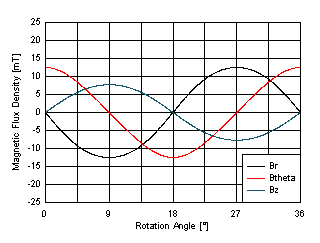SBAA449B October 2020 – October 2021 TMAG5110 , TMAG5110-Q1 , TMAG5111 , TMAG5111-Q1
4.1 Optimizing Placement for Accuracy
From our findings based on sensor placement we can deduce a method to minimize the error that results from mismatch in each field component. Consider Figure 4-1 which shows a side view of the 20-pole ring magnet we have been analyzing.
 Figure 4-1 Finding Optimal Placement
Figure 4-1 Finding Optimal PlacementA simulation sweep to find a possible position III resulted with an angle of 38.9°. Matching between Br and Bθ was achieved at this angle when using a fixed range of 3.25 mm to the center of the face of the magnet. Magnetic field components can be seen in Figure 4-2.
The resulting Br and Bθ fields have a peak amplitude of 12.4 mT, and the resulting worst case angular error of 0.85° will be entirely due to sensitivity mismatch.
 Figure 4-2 Bz and Bθ Matched
Figure 4-2 Bz and Bθ MatchedAs an alternative to finding the ideal placement of the sensor, it will also be beneficial to consider how to modify the magnet to improve performance as well.